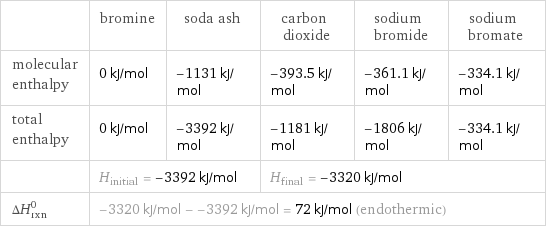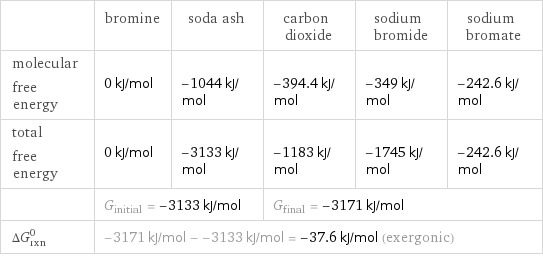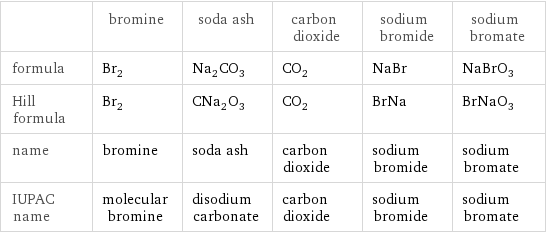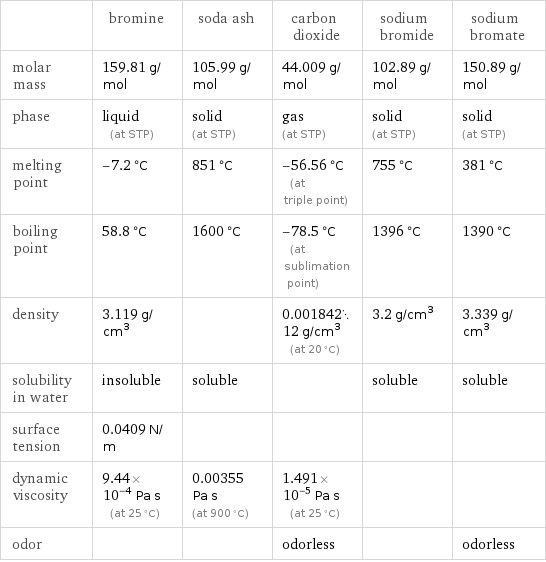Input interpretation

Br_2 bromine + Na_2CO_3 soda ash ⟶ CO_2 carbon dioxide + NaBr sodium bromide + NaBrO_3 sodium bromate
Balanced equation

Balance the chemical equation algebraically: Br_2 + Na_2CO_3 ⟶ CO_2 + NaBr + NaBrO_3 Add stoichiometric coefficients, c_i, to the reactants and products: c_1 Br_2 + c_2 Na_2CO_3 ⟶ c_3 CO_2 + c_4 NaBr + c_5 NaBrO_3 Set the number of atoms in the reactants equal to the number of atoms in the products for Br, C, Na and O: Br: | 2 c_1 = c_4 + c_5 C: | c_2 = c_3 Na: | 2 c_2 = c_4 + c_5 O: | 3 c_2 = 2 c_3 + 3 c_5 Since the coefficients are relative quantities and underdetermined, choose a coefficient to set arbitrarily. To keep the coefficients small, the arbitrary value is ordinarily one. For instance, set c_5 = 1 and solve the system of equations for the remaining coefficients: c_1 = 3 c_2 = 3 c_3 = 3 c_4 = 5 c_5 = 1 Substitute the coefficients into the chemical reaction to obtain the balanced equation: Answer: | | 3 Br_2 + 3 Na_2CO_3 ⟶ 3 CO_2 + 5 NaBr + NaBrO_3
Structures

+ ⟶ + +
Names

bromine + soda ash ⟶ carbon dioxide + sodium bromide + sodium bromate
Reaction thermodynamics
Enthalpy

| bromine | soda ash | carbon dioxide | sodium bromide | sodium bromate molecular enthalpy | 0 kJ/mol | -1131 kJ/mol | -393.5 kJ/mol | -361.1 kJ/mol | -334.1 kJ/mol total enthalpy | 0 kJ/mol | -3392 kJ/mol | -1181 kJ/mol | -1806 kJ/mol | -334.1 kJ/mol | H_initial = -3392 kJ/mol | | H_final = -3320 kJ/mol | | ΔH_rxn^0 | -3320 kJ/mol - -3392 kJ/mol = 72 kJ/mol (endothermic) | | | |
Gibbs free energy

| bromine | soda ash | carbon dioxide | sodium bromide | sodium bromate molecular free energy | 0 kJ/mol | -1044 kJ/mol | -394.4 kJ/mol | -349 kJ/mol | -242.6 kJ/mol total free energy | 0 kJ/mol | -3133 kJ/mol | -1183 kJ/mol | -1745 kJ/mol | -242.6 kJ/mol | G_initial = -3133 kJ/mol | | G_final = -3171 kJ/mol | | ΔG_rxn^0 | -3171 kJ/mol - -3133 kJ/mol = -37.6 kJ/mol (exergonic) | | | |
Equilibrium constant
![Construct the equilibrium constant, K, expression for: Br_2 + Na_2CO_3 ⟶ CO_2 + NaBr + NaBrO_3 Plan: • Balance the chemical equation. • Determine the stoichiometric numbers. • Assemble the activity expression for each chemical species. • Use the activity expressions to build the equilibrium constant expression. Write the balanced chemical equation: 3 Br_2 + 3 Na_2CO_3 ⟶ 3 CO_2 + 5 NaBr + NaBrO_3 Assign stoichiometric numbers, ν_i, using the stoichiometric coefficients, c_i, from the balanced chemical equation in the following manner: ν_i = -c_i for reactants and ν_i = c_i for products: chemical species | c_i | ν_i Br_2 | 3 | -3 Na_2CO_3 | 3 | -3 CO_2 | 3 | 3 NaBr | 5 | 5 NaBrO_3 | 1 | 1 Assemble the activity expressions accounting for the state of matter and ν_i: chemical species | c_i | ν_i | activity expression Br_2 | 3 | -3 | ([Br2])^(-3) Na_2CO_3 | 3 | -3 | ([Na2CO3])^(-3) CO_2 | 3 | 3 | ([CO2])^3 NaBr | 5 | 5 | ([NaBr])^5 NaBrO_3 | 1 | 1 | [NaBrO3] The equilibrium constant symbol in the concentration basis is: K_c Mulitply the activity expressions to arrive at the K_c expression: Answer: | | K_c = ([Br2])^(-3) ([Na2CO3])^(-3) ([CO2])^3 ([NaBr])^5 [NaBrO3] = (([CO2])^3 ([NaBr])^5 [NaBrO3])/(([Br2])^3 ([Na2CO3])^3)](../image_source/c201e1d1c82b421c5c4e51a06d72668a.png)
Construct the equilibrium constant, K, expression for: Br_2 + Na_2CO_3 ⟶ CO_2 + NaBr + NaBrO_3 Plan: • Balance the chemical equation. • Determine the stoichiometric numbers. • Assemble the activity expression for each chemical species. • Use the activity expressions to build the equilibrium constant expression. Write the balanced chemical equation: 3 Br_2 + 3 Na_2CO_3 ⟶ 3 CO_2 + 5 NaBr + NaBrO_3 Assign stoichiometric numbers, ν_i, using the stoichiometric coefficients, c_i, from the balanced chemical equation in the following manner: ν_i = -c_i for reactants and ν_i = c_i for products: chemical species | c_i | ν_i Br_2 | 3 | -3 Na_2CO_3 | 3 | -3 CO_2 | 3 | 3 NaBr | 5 | 5 NaBrO_3 | 1 | 1 Assemble the activity expressions accounting for the state of matter and ν_i: chemical species | c_i | ν_i | activity expression Br_2 | 3 | -3 | ([Br2])^(-3) Na_2CO_3 | 3 | -3 | ([Na2CO3])^(-3) CO_2 | 3 | 3 | ([CO2])^3 NaBr | 5 | 5 | ([NaBr])^5 NaBrO_3 | 1 | 1 | [NaBrO3] The equilibrium constant symbol in the concentration basis is: K_c Mulitply the activity expressions to arrive at the K_c expression: Answer: | | K_c = ([Br2])^(-3) ([Na2CO3])^(-3) ([CO2])^3 ([NaBr])^5 [NaBrO3] = (([CO2])^3 ([NaBr])^5 [NaBrO3])/(([Br2])^3 ([Na2CO3])^3)
Rate of reaction
![Construct the rate of reaction expression for: Br_2 + Na_2CO_3 ⟶ CO_2 + NaBr + NaBrO_3 Plan: • Balance the chemical equation. • Determine the stoichiometric numbers. • Assemble the rate term for each chemical species. • Write the rate of reaction expression. Write the balanced chemical equation: 3 Br_2 + 3 Na_2CO_3 ⟶ 3 CO_2 + 5 NaBr + NaBrO_3 Assign stoichiometric numbers, ν_i, using the stoichiometric coefficients, c_i, from the balanced chemical equation in the following manner: ν_i = -c_i for reactants and ν_i = c_i for products: chemical species | c_i | ν_i Br_2 | 3 | -3 Na_2CO_3 | 3 | -3 CO_2 | 3 | 3 NaBr | 5 | 5 NaBrO_3 | 1 | 1 The rate term for each chemical species, B_i, is 1/ν_i(Δ[B_i])/(Δt) where [B_i] is the amount concentration and t is time: chemical species | c_i | ν_i | rate term Br_2 | 3 | -3 | -1/3 (Δ[Br2])/(Δt) Na_2CO_3 | 3 | -3 | -1/3 (Δ[Na2CO3])/(Δt) CO_2 | 3 | 3 | 1/3 (Δ[CO2])/(Δt) NaBr | 5 | 5 | 1/5 (Δ[NaBr])/(Δt) NaBrO_3 | 1 | 1 | (Δ[NaBrO3])/(Δt) (for infinitesimal rate of change, replace Δ with d) Set the rate terms equal to each other to arrive at the rate expression: Answer: | | rate = -1/3 (Δ[Br2])/(Δt) = -1/3 (Δ[Na2CO3])/(Δt) = 1/3 (Δ[CO2])/(Δt) = 1/5 (Δ[NaBr])/(Δt) = (Δ[NaBrO3])/(Δt) (assuming constant volume and no accumulation of intermediates or side products)](../image_source/26b843b7c0329972ff5a5500f26d1b46.png)
Construct the rate of reaction expression for: Br_2 + Na_2CO_3 ⟶ CO_2 + NaBr + NaBrO_3 Plan: • Balance the chemical equation. • Determine the stoichiometric numbers. • Assemble the rate term for each chemical species. • Write the rate of reaction expression. Write the balanced chemical equation: 3 Br_2 + 3 Na_2CO_3 ⟶ 3 CO_2 + 5 NaBr + NaBrO_3 Assign stoichiometric numbers, ν_i, using the stoichiometric coefficients, c_i, from the balanced chemical equation in the following manner: ν_i = -c_i for reactants and ν_i = c_i for products: chemical species | c_i | ν_i Br_2 | 3 | -3 Na_2CO_3 | 3 | -3 CO_2 | 3 | 3 NaBr | 5 | 5 NaBrO_3 | 1 | 1 The rate term for each chemical species, B_i, is 1/ν_i(Δ[B_i])/(Δt) where [B_i] is the amount concentration and t is time: chemical species | c_i | ν_i | rate term Br_2 | 3 | -3 | -1/3 (Δ[Br2])/(Δt) Na_2CO_3 | 3 | -3 | -1/3 (Δ[Na2CO3])/(Δt) CO_2 | 3 | 3 | 1/3 (Δ[CO2])/(Δt) NaBr | 5 | 5 | 1/5 (Δ[NaBr])/(Δt) NaBrO_3 | 1 | 1 | (Δ[NaBrO3])/(Δt) (for infinitesimal rate of change, replace Δ with d) Set the rate terms equal to each other to arrive at the rate expression: Answer: | | rate = -1/3 (Δ[Br2])/(Δt) = -1/3 (Δ[Na2CO3])/(Δt) = 1/3 (Δ[CO2])/(Δt) = 1/5 (Δ[NaBr])/(Δt) = (Δ[NaBrO3])/(Δt) (assuming constant volume and no accumulation of intermediates or side products)
Chemical names and formulas

| bromine | soda ash | carbon dioxide | sodium bromide | sodium bromate formula | Br_2 | Na_2CO_3 | CO_2 | NaBr | NaBrO_3 Hill formula | Br_2 | CNa_2O_3 | CO_2 | BrNa | BrNaO_3 name | bromine | soda ash | carbon dioxide | sodium bromide | sodium bromate IUPAC name | molecular bromine | disodium carbonate | carbon dioxide | sodium bromide | sodium bromate
Substance properties

| bromine | soda ash | carbon dioxide | sodium bromide | sodium bromate molar mass | 159.81 g/mol | 105.99 g/mol | 44.009 g/mol | 102.89 g/mol | 150.89 g/mol phase | liquid (at STP) | solid (at STP) | gas (at STP) | solid (at STP) | solid (at STP) melting point | -7.2 °C | 851 °C | -56.56 °C (at triple point) | 755 °C | 381 °C boiling point | 58.8 °C | 1600 °C | -78.5 °C (at sublimation point) | 1396 °C | 1390 °C density | 3.119 g/cm^3 | | 0.00184212 g/cm^3 (at 20 °C) | 3.2 g/cm^3 | 3.339 g/cm^3 solubility in water | insoluble | soluble | | soluble | soluble surface tension | 0.0409 N/m | | | | dynamic viscosity | 9.44×10^-4 Pa s (at 25 °C) | 0.00355 Pa s (at 900 °C) | 1.491×10^-5 Pa s (at 25 °C) | | odor | | | odorless | | odorless
Units
